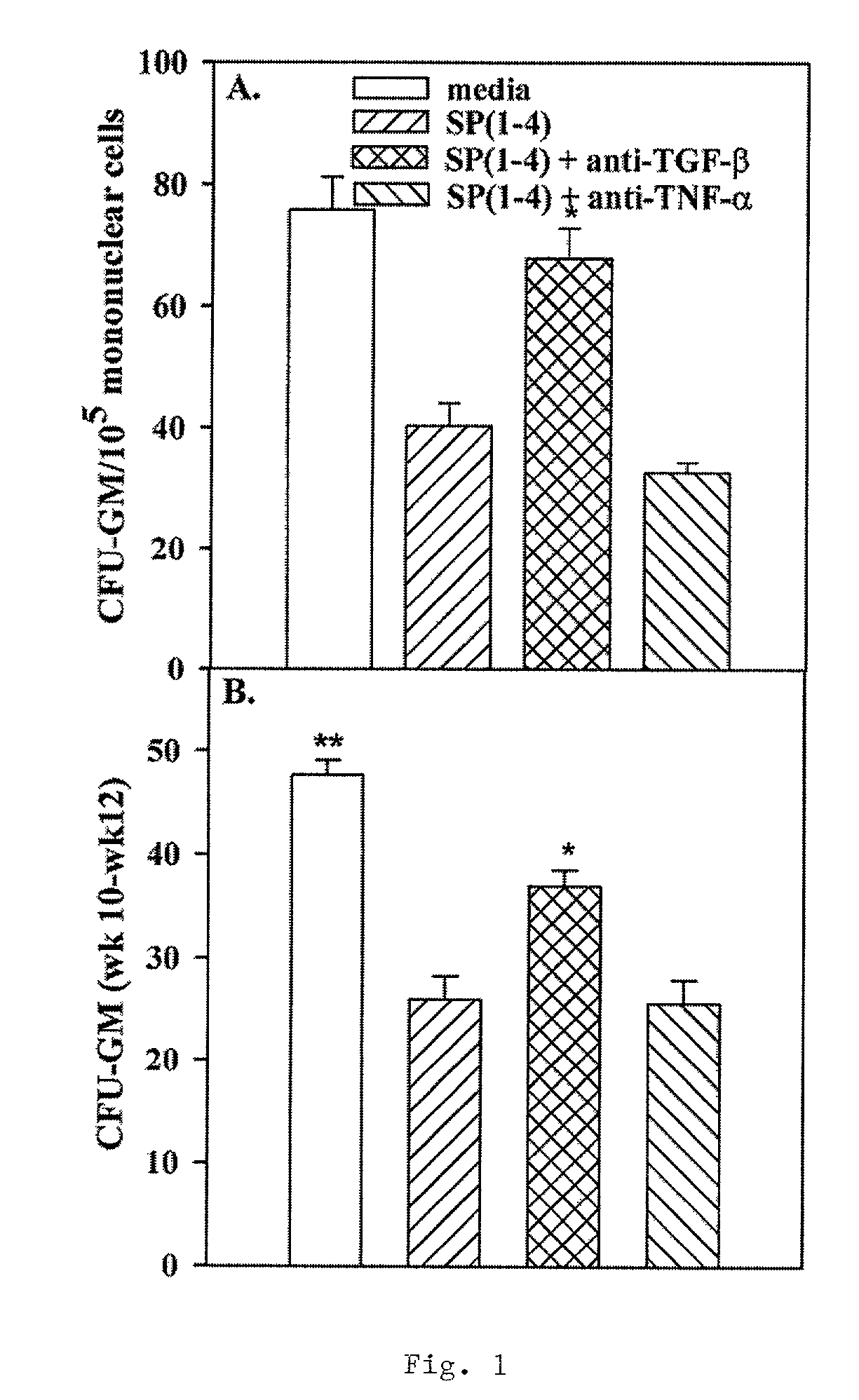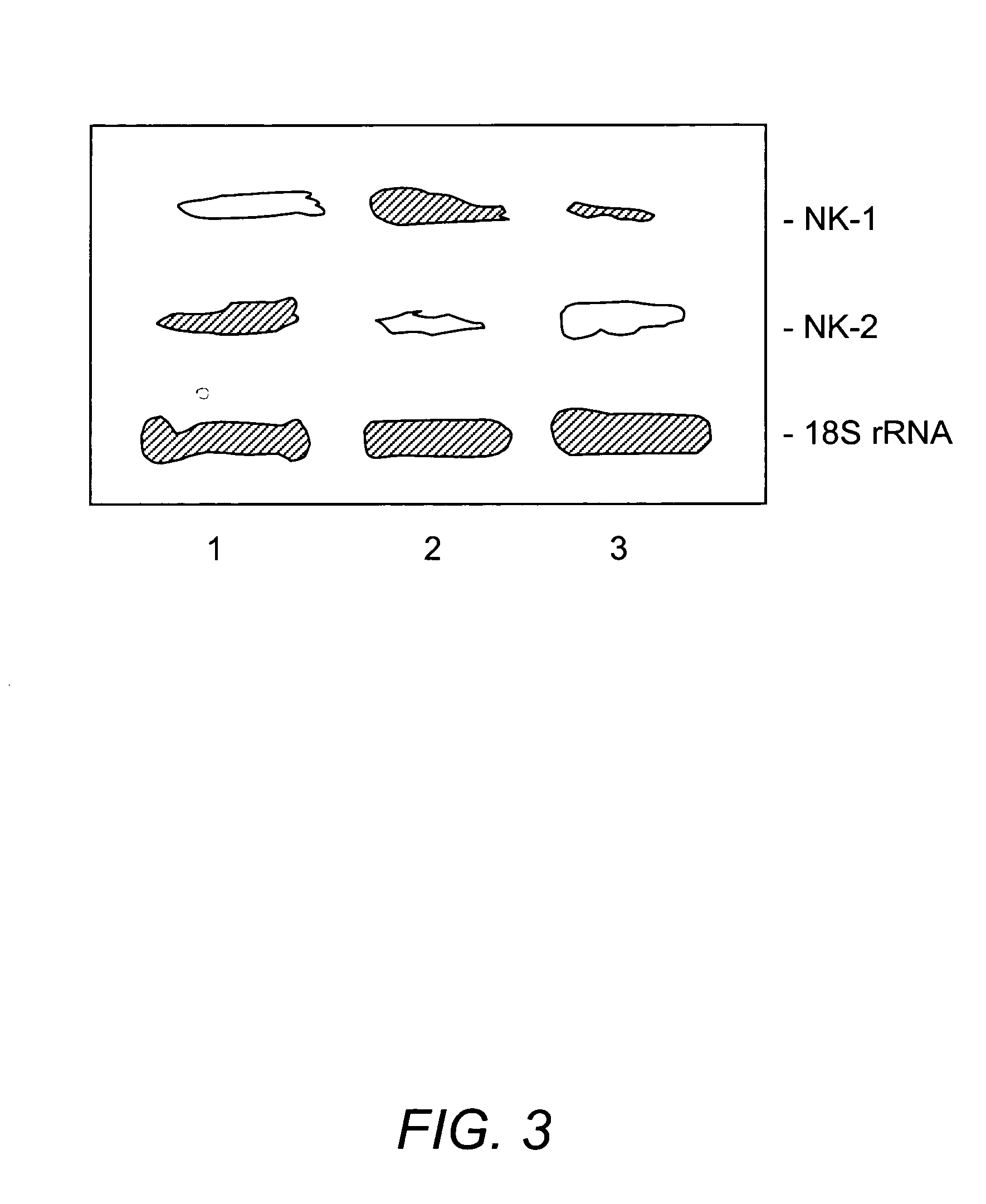Amino terminal substance P compositions and methods for using the same
- Summary
- Abstract
- Description
- Claims
- Application Information
AI Technical Summary
Benefits of technology
Problems solved by technology
Method used
Image
Examples
examples
[0150]The following description sets forth the general procedures involved in practicing the present invention. To the extent that specific materials are mentioned, it is merely for purposes of illustration and is not intended to limit the invention. Unless other-wise specified, general cloning procedures, such as those set forth in Sambrook et al., Molecular Cloning, supra or Ausubel et al., (eds) Current Protocols in Molecular Biology, John Wiley & Sons (2000) (hereinafter “Ausubel et al.”) are used. See the examples below for further details.
example i
[0151]A. Reagents, Cytokines and Antibodies
[0152]SP, SP(1-4), thiazolyl blue (MTT), spantide, Ficoll-Hypaque and non-immune rabbit serum were purchased from Sigma (St. Louis, Mo.). Spantide, SP and SP(1-4) were dissolved and stored as described22. Biotin-SP and biotin-NK-A were purchased from Peninsula Laboratories (Belmont, Calif.). Alkaline phosphatase (Alk Phos)—conjugated goat anti-rabbit IgG was obtained from Kirkegaard & Perry Laboratories Inc. (Gaithersburg, Md.). Rabbit anti-SP was purchased from Biogenesis (Brentwood, N.H.). The Immunology Department of Genetics Institute (Cambridge, Mass.) provided recombinant human (rh) GM-CSF. FITC-avidin was purchased from Vector Laboratories (Burlingame, Calif.). SCF, TGF-β1, TNF-α, goat anti-hTNF-α, rabbit anti-hTGF-13, biotinylated goat anti-hSCF receptor (c-kit), non-immune rabbit IgG, and biotinylated non-immune goat IgG were purchased from R&D Systems (Minneapolis, Minn.). Functional studies indicated that anti-hTGF-β exerts speci...
example ii
[0177]A. Profiling for SP and SP(1-4) by ProteinChip Analyses
[0178]SP and SP(1-4) were profiled in stromal cell extracts using Ciphergen's ProteinChip® Technology (Ciphergen Biosystems Inc., Fremont, Calif.). Weak Cation Exchanger (WCX2) ProteinChip array (for profiling) and the pre-activated chip surface, PS1 (for affinity studies) were used for the identification of SP(1-4). The basic method, which was provided by Ciphergen was adjusted to optimize the analyses that follow. Stromal cells were washed with PBS and then subjected to repeated freeze-thaw. Cell-free lysates were prepared by centrifuging at 4° C. for 30 min / 15,000 g. WCX2 was pre-treated with 10 mM HCl and 500 μL of each sample was spotted on the array using a bio-processor. The chips were incubated at room temperature for 30 min with vigorous shaking to ensure binding of sample to array. Subsequently, chips were washed with 5% Triton / PBS (2×) and with PBS (1×). A saturated solution of a-cyano-4-hydroxy cinnamic acid (C...
PUM
| Property | Measurement | Unit |
|---|---|---|
| Fraction | aaaaa | aaaaa |
| Toxicity | aaaaa | aaaaa |
Abstract
Description
Claims
Application Information
 Login to View More
Login to View More - R&D
- Intellectual Property
- Life Sciences
- Materials
- Tech Scout
- Unparalleled Data Quality
- Higher Quality Content
- 60% Fewer Hallucinations
Browse by: Latest US Patents, China's latest patents, Technical Efficacy Thesaurus, Application Domain, Technology Topic, Popular Technical Reports.
© 2025 PatSnap. All rights reserved.Legal|Privacy policy|Modern Slavery Act Transparency Statement|Sitemap|About US| Contact US: help@patsnap.com



